Until the coastal road connected Portofino to neighbouring Santa Margherita, crossing the promontory on foot was the only way to reach the harbour by land. Today it’s a National Park, with 80-km of hiking routes winding through sweeping landscapes, while hinting at the cultural heritage of rural Portofino.
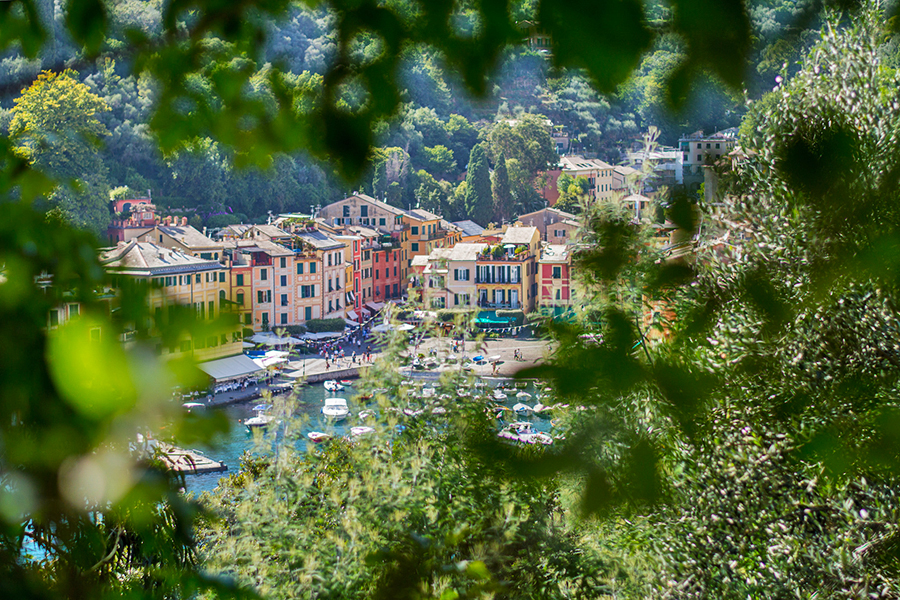
Portofino through the trees (Photo: buothz via Flickr/CC BY 2.0)
The belle époque facade of the Kulm Hotel has been guarding the north end of the promontory for over a century. Currently closed, the hotel still makes an excellent starting point for a hike in the National Park, where the view embraces a wide stretch of the Ligurian Riviera and on clear days reaches as far as the Maritime Alps.
It wasn’t the case on my day trip – unsurprising for an afternoon in early January – as thick clouds loomed. Rain would have caught me ill-equipped, but I took my chances and headed for Portofino, roughly 5km away, eager to discover what the harbour looked like when approached from the mountain.
The mountain
The deep green of the cluster pines greeted me, contrasting the chestnut trees’ bare branches, through which I could glimpse the sea. It took only a short time to become accustomed to the brisk ambience of the woodland, before the track descended gently into a shaded valley.
While most trails are relatively undemanding, others require a more commitment and physical preparation. Two examples are the Pipes Path and the Kiss Pass, the former following an old aqueduct, the latter named after two local Romeo and Juliet who, so the story goes, preferred to jump together off a cliff rather than relinquish their love. Due to their difficulty, however, these trails are only accessible on a guided tour.
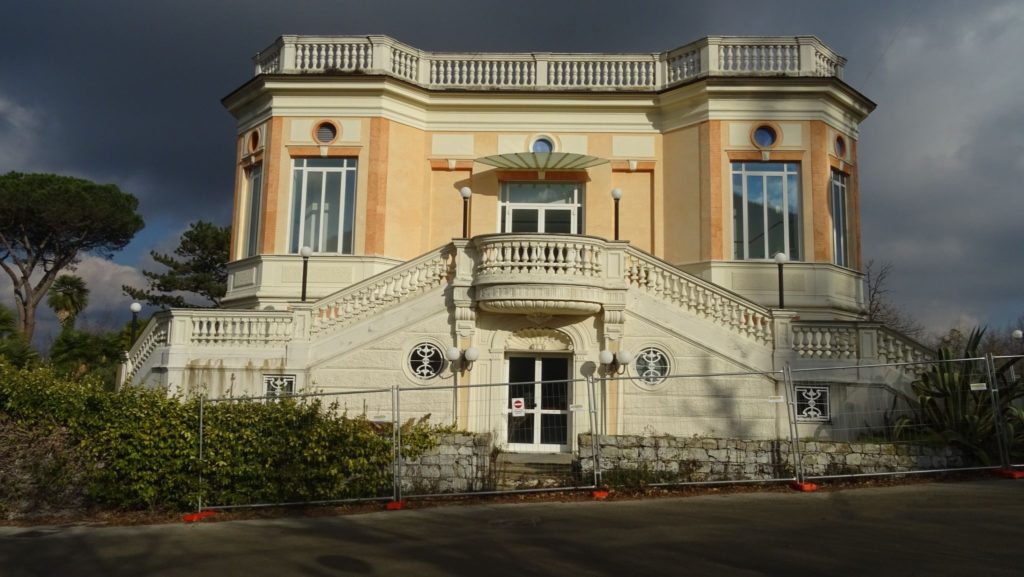
The 1907 opening of Kulm Hotel was advertised all over Europe (Photo: Andrea Gambaro)
I deviated from my safe route soon after, onto a narrow sidepath. As I walked on, now uphill, the track gradually faded into a crackling blanket of dead leaves and fallen logs. The sight of the Tigullian and the Paradiso Gulfs on the two sides of the promontory helped me navigate more than once, while Portofino was still hiding in its cove somewhere ahead.
No white patches stained the 610-meter peak of the mountain, towering behind me, but winter snowfall is not unusual. By contrast, 300 meters away, as the crow flies, one might stumble upon species of plant otherwise found only along the North African coast.
Such a complex environment appealed to the early visitors of modern times, namely 18th and 19th century travellers from Northern Europe, who initiated the village’s slide to popularity while seeking refuge during colder months. Often they were artists and intellectuals moved by the spirit of Romanticism, who found among the mountain’s chestnut trees the same atmosphere of the mainland forests, coupled with a more benevolent Mediterranean climate, like Friederich’s ‘Wanderer Above the Sea of Fog’, but without the fog.
Another landscape
By that same token, the grey sky vanished, rewarding my earlier leap of faith. The sun beamed down, dispersing the clouds and unveiling a vivid green slope of woods, grassland, farming terraces and tidily-aligned olive trees. The few houses shoring up the scene were the first I came across since leaving the Kulm behind.
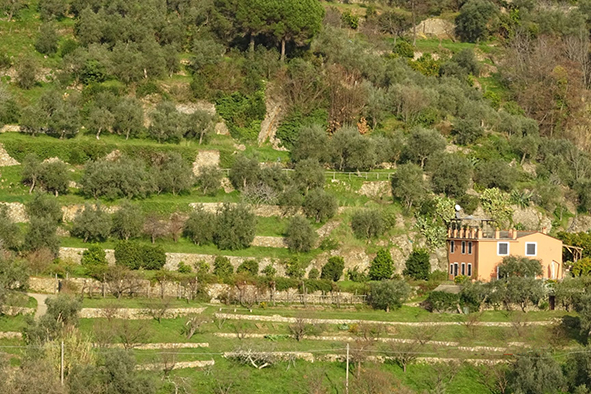
Farming terraces (Photo: Andrea Gambaro)
That was what most of the mountain would have looked like, when Portofino was still living off farming and fishing, until the early 20th century. However the local economy had started to be reshaped by the rise of tourism, which was bringing more winter guests to the village. Traditional employment adapted accordingly; the mountain gradually depopulated and the briar, now scattered all over the upper part of the promontory, began poking its way through the formerly well-tended land.
The closer I got to the sea, the more hamlets I encountered. The church of Nozarego, overlooking Santa Margherita, made me realise I had missed a turn. Rerouting south, a crêuza (the local word for ‘mule track’) ran along the hillside through a typical Ligurian scene: undulating, narrow cobbled pathways, flanked by dry-stone walls and sun-drenched olive trees. Looking down towards the sea, the shore was hidden behind maritime pines and palm trees, while terraces sketched horizontal patterns on the hill slopes.
Further ahead was the Valle dei Mulini (Mills Valley), cut out by one of the few creeks that spring in the area. Of the many medieval mills that used to line the creek, all but one have been reduced to ruins. No longer active as a mill, the Gassetta is now a restaurant, resting spot and eco-museum, after being converted in the early 1970s. By then, deeper transformations had taken place down in the village.
The 1950s and 60s were the backdrop for a radical makeover of day-to-day life in Portofino. Often included in the itinerary of the jet-set, the piazzetta had become an icon of the Italian dolce vita staged by actors, singers, stylists, billionaires and celebrities of any sort, all captured by the paparazzi cameras. Restaurants, bars and boutiques replaced the old warehouses, boosting a transition started a few decades earlier. Fishing boats in the harbour were edged out by yachts and tourist ferries.
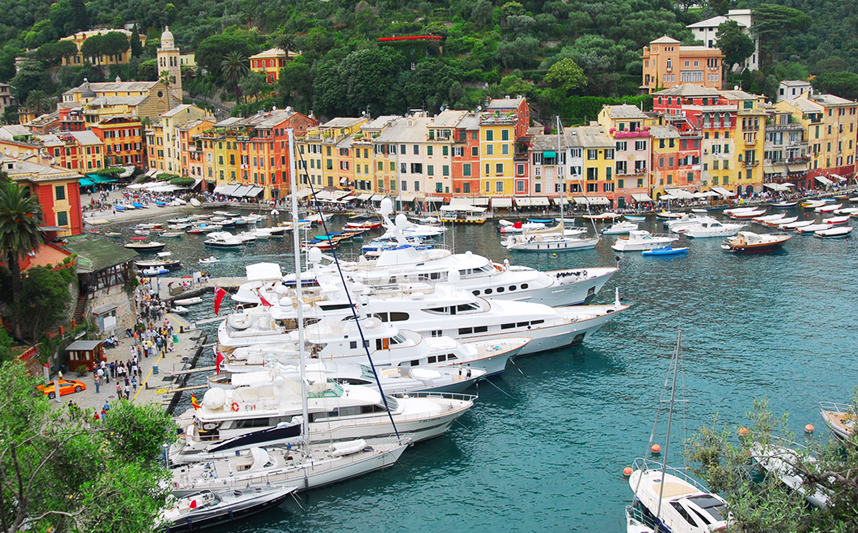
Super yachts regularly seen in Portofino during the summer (Photo: Fabrizio via Flickr / CC BY 2.0
)
The winter refuge for stationary guests soon turned into a VIP summer resort visited by ‘hit-and-run’ crowds of tourists, a state that to a large extent still applies nowadays. If the sudden, worldwide fame won the village unprecedented wealth, inflated prices and the erosion of the traditional economy didn’t benefit the whole local community. In fact, Portofino’s population has since more than halved, today amounting to roughly 400, and the trend doesn’t seem to be reversing.
In sight
The trail past the mill became a long, steep run towards the harbour; the open sea was now close enough to spot a solitary boat floating on the calm water. As I walked past one of the many villas left empty during low season, two bricklayers cleared some tools from the path to let me through and carried on working on the uphill facade. On the other side, a small door left ajar onto a panoramic garden was too tempting to ignore; nobody was around after all, and by the clattering of picks and pulleys I could tell the bricklayers weren’t disturbed.
A few steps into the garden and the brief trespassing proved worthwhile: there lay Portofino, making me wonder if it was from a similar spot that Friedrich Nietzsche described the area as “an island in the Hellenic archipelagos, on which mountains and forests alternate capriciously, that one day, for who knows what phenomenon, you’ve navigated towards land and there you anchor and never leave”.
That viewpoint highlighted the blessed location of the Portofino harbour, sheltered by the south end of the promontory. Castello Brown was perched there over the sea. I hoped to get that far, and at the very least visit Saint George Church, said to contain the relics of its namesake since the age of the Crusades.
Local devotion to the ‘dragon slayer’ is renewed every year by a ritual whose origins go as far back as pagan times. On 23 April, a propitiatory bonfire burns in the piazzetta, and relics are paraded through the village. Being busy even on Saint George’s Day, fishermen in the old times used to join the celebration when nothing but glowing embers were left of the bonfire, on top of which they would place platters made of slate in order to cook some of the day’s catch. In sciä ciàppa (‘on the slate’) became the local way of cooking fish.
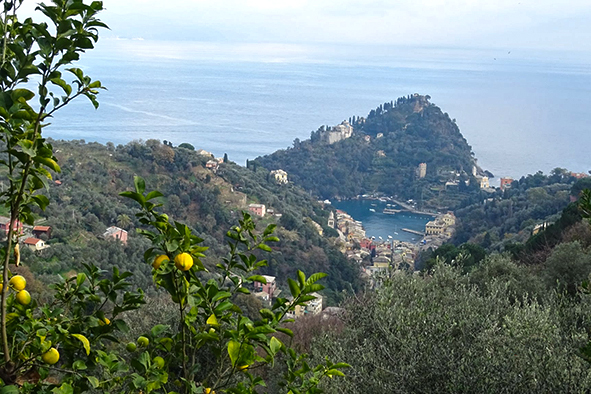
Castle Brown and Saint George Church overlook the harbour (Photo: Andrea Gambaro)
The village
As I walked down an empty Via Roma, heading for the marina, fashion brands and lowered shutters frustrated any effort of imagination to picture those premises as they used to be, packed with salt-corroded floats and covered with dripping fishing nets.
An elderly couple were all alone in the waterfront piazzetta, enjoying the fading winter daylight, while a handful of locals gathered at the only open café. The three or four tourists in sight walked sluggishly along the dock. As for the few small boats moored in the harbour, they seemed serenely resigned to do without bigger spit-polished companions, maybe for another month or two.
It had gotten dark enough for me to postpone the last part of the itinerary for another visit. I stayed a little longer by the shore, thinking that in such a semi-deserted backdrop, unaware of high-season crowds, the image of Portofino may well appear as timeless as Nietzsche’s Hellenic island lost in the Mediterranean.
One should not be fooled though, for the arched row of houses along the shore surely took the place of a previous landscape, and yet another will follow one day. Above it, the mountain sits as perhaps the only enduring witness.
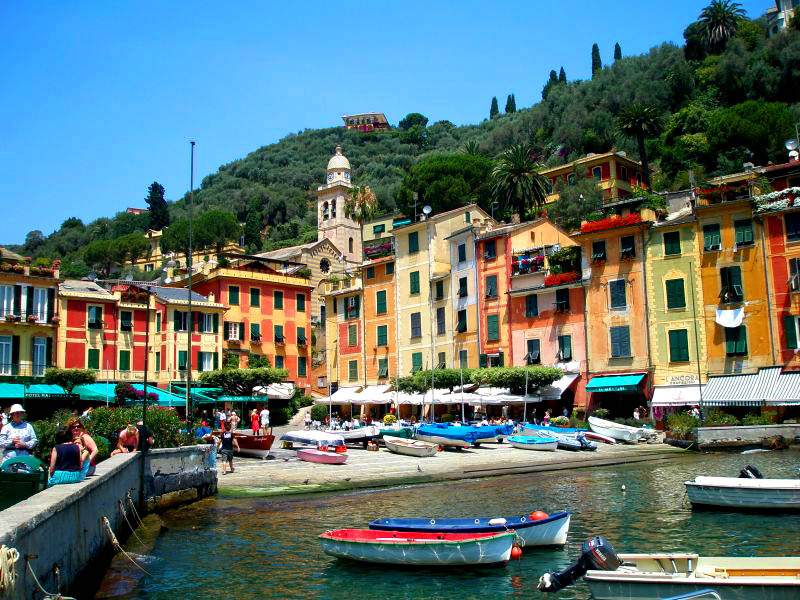
Portofino is a pretty little former fishing village (Photo: Fangfei Shen via Flickr / CC BY 2.0)